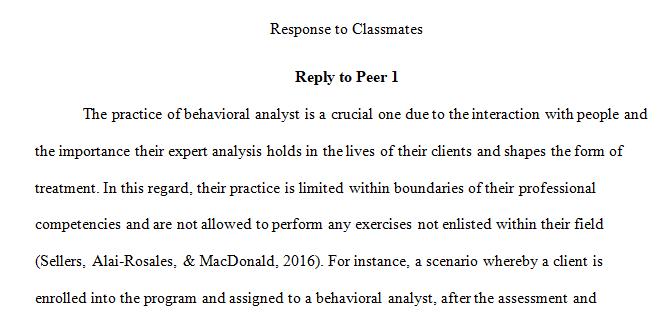
Respond to two classmates’ primary posts by selecting one of the subsections of Code 1.0 they chose to explain and provide a scenario, based upon that subsection, that demonstrates a violation of that specific code, and explain the potential harm that violation may cause. Select a different subsection to cover in each response.
Response to Classmates
Respond to two classmates’ primary posts by selecting one of the subsections of Code 1.0 they chose to explain and provide a scenario, based upon that subsection, that demonstrates a violation of that specific code, and explain the potential harm that violation may cause. Select a different subsection to cover in each response.
Peer 1:
Subsection 1.02: With this subsection a behavioral analysist should only provide services, teach, and conduct research based off the boundaries of their competence (Bailey, 2016). A behavioral analyst can also only provide services, conduct research or teach in new areas of competence once they have gone through appropriate supervision or training for that area (Bailey, 2016). This subsection impacts the profession of ABA since it can affect how our clients are treated. If a behavioral analyst treats a client beyond what they are competent in, then it can potentially hurt the client’s progress and could affect others as well.
Subsection 1.04: This subsection talks about integrity of a behavioral analyst. This code states that a behavioral analyst is expected to always be honest and truthful with others (Bailey, 2016). Also, with this subsection it outlines the that a behavioral analyst should always follow through on professional commitments and also make sure to not implement a contingency that causes others to engage in illegal or unethical behaviors (Bailey, 2016). This subsection could potentially affect the profession and research of applied behavioral analysis since it could cause doubt of the integrity of the research or even of the profession as a whole, if behavioral analysist are not open and honest with each other and with the clients and their family.
Subsection 1.06: With this subsection, it talks about conflicts of interest and multiple relationships. A behavioral analyst will be careful to avoid multiple relationships with a client (Bailey, 2016). A multiple relationship can occur when the behavioral analyst has a professional relationship with a person and another type of relationship with the client. (Bailey, 2016) With having multiple relationships with clients, it could cause the objectivity of the behavioral analyst to be impaired due to the multiple relationships (Bailey, 2016).
Reference:
Bailey, J., Burch, M. (20160322). Ethics for Behavior Analysts, 3rd Edition [VitalSource Bookshelf version]. Retrieved from vbk://9781317363439
Peer 2:
Code 1.02- Boundaries of Competence: Behavior analyst are expected to provide services and conduct research within the boundaries of their competence. One can provide services, teach, or conduct research in new areas after studying, training, and gaining supervision from those who are competent in the specific area (Bailey & Burch, 2016).
Code 1.04- Integrity: The behavior analyst should be truthful and honest while also promoting truthful and honest behaviors in others. Refrain from implementing contingencies that leads to fraudulent, illegal, or unethical conduct. Follow through with professional commitments and avoid making a commitment they can not keep. Comply with legal and ethical codes of the social and professional community they are members of. If an ethical responsibility conflicts with the law, then steps need to be taken to resolve the conflict in accordance with the law (Bailey & Burch, 2016).
Code 1.06- Multiple Relationships and Conflict of Interest: Behavior analyst should avoid multiple relationships. They must be sensitive to the potential or harmful effects of multiple relationships and if one arises, then resolve it. They should also inform clients and employees of the harmful effects of multiple relationships (Bailey & Burch, 2016).
By not following code 1.02 you could potentially engage in mistreatment of your client and misrepresenting your qualifications. You run the risk of a malpractice lawsuit and losing your job. If you do not follow code 1.04 then you run the risk of insurance fraud and losing your job. By not following code 1.06 you may not be able to satisfy clients. Employees can become uncomfortable and leave their company and relationships can turn bad. By not abiding by the codes you are violating the ethics codes. You run the risk of losing your job and placing a bad reputation on ABA and your company. When you follow these codes you prevent mistreatment, misrepresenting your qualifications, insurance fraud, awkward situations, loss of employees, clients, and business, malpractice lawsuits, and bad reputations (Bailey & Burch, 2016).
Bailey, J. & Burch, M. (2016). Ethics for Behavior Analysts, 3rd Edition. [Purdue University Global Bookshelf]. Retrieved from https://purdueuniversityglobal.vitalsource.com/#/books/9781317363439/
4 hours ago
REQUIREMENTS
Purdue Global University PS385 Targeted Behavior in ABA
Psychology
Answer preview…………………..
 apa 563 words
apa 563 words